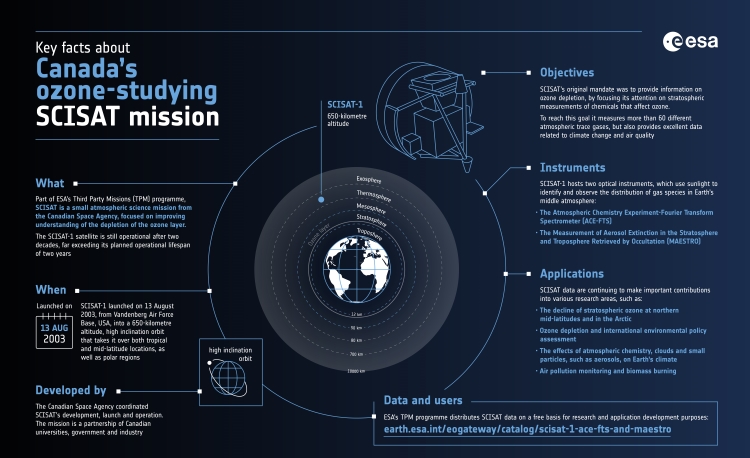- SCISAT-1
- Mission
- SCISAT-1 Overview
SCISAT-1 Overview
Mission Background
During 1996/97, CSA (Canadian Space Agency) initiated the SCISAT programme with the objective to provide opportunities for Canadian scientists to define and conduct space experiments in the following fields: Earth sciences, space astronomy, and solar-terrestrial relations. Mission selection procedures in the programme were conducted via an AO (Announcement of Opportunity) process and peer reviews.
SCISAT Infographic
Learn more about the SCISAT mission in this infographic:

Satellite Design
The SCISAT-1 minisatellite structure was designed, built and integrated by Canadian industry. It uses a circular instrument/component aluminum mounting plate as the main structure of the platform. The spacecraft is three-axis stabilised. Attitude control is based on a bias momentum stabilisation approach. The subsystem consists of a momentum wheel, torque rods along all three body-fixed axes, one fine sun sensor, a magnetometer and a set of six coarse Sun sensors. All sensors and actuators are off-the-shelf components with flight heritage.
| Mass | 260 kg |
| Dimensions | 1.5 m x 1.5 m |
| Design Lifetime | 2 years |
Mission Operations
SCISAT-1 is in a geocentric low Earth orbit. SCISAT-1 passes through Earth's shadow 15 times per day, profiting from the occultation of the Sun to make a spectrographic analysis of the structure and chemistry of those parts of the upper atmosphere that are too high to be reached by balloons and airplanes and too low to be visited by orbiting satellites. This kind of analysis can help understand the depletion of the ozone layer and other upper atmosphere phenomena.
Related Links
Learn more about SCISAT-1 from these related websites:
*The information provided is sourced and updated by external entities. For further details, please consult our Terms and Conditions page.